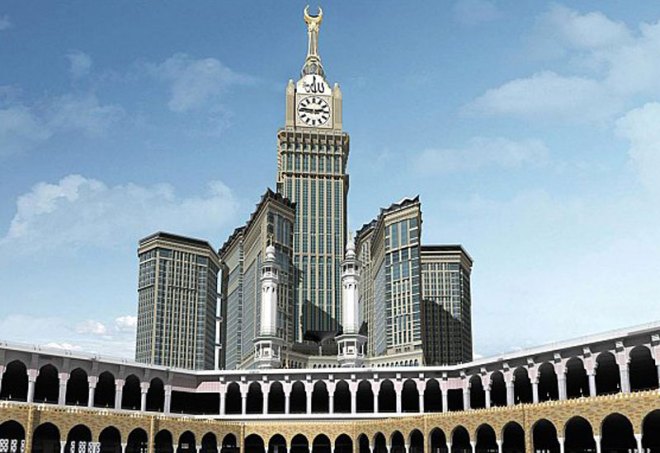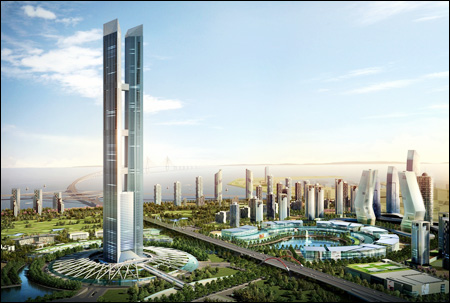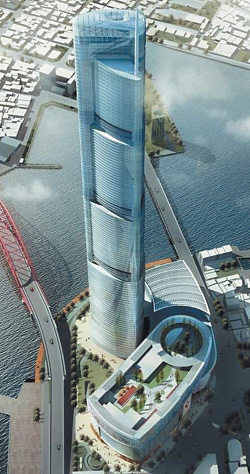It’s hard to imagine large metropolises without thinking of their accompanying skyscrapers. However, until the late 19th century, the only tall buildings in large cities were churches and cathedrals, which ranged anywhere from a couple dozen to a few hundred feet. Once it was discovered that steel could be mass-produced at a relatively low cost, humanity began a race into the troposphere. Lightweight (compared to brick and stone) steel skeletons rose to dizzying heights all over American cities.
It’s hard to believe that within the span of about a hundred years, skyscrapers have literally become thousands of feet taller. Philadelphia City Hall, completed in 1908, barely scraped the sky at only 548 ft. By 1931, the Chrysler Building became the first building to exceed one thousand feet. However, it was soon dethroned as king of the tallest a year later when the Empire State Building went a few hundred feet higher, 1,250 ft (not including pinnacle and antenna, which brings the height to 1,454 ft.). The original World Trade Center, completed in the early 1970s, rose about one hundred feet higher than the Empire State Building, taking the title at 1,368 feet (not including antenna – 1,727 ft.). The Twin Towers of the World Trade Center didn’t even hold the title for a year; Sears Tower overtook the twin towers at 1,450 feet a few months later in 1973, the same year the World Trade Center was completed. In 1998, the Petronas Towers were completed, snatching the ever-moving title of tallest building to 1,483 feet. By the end of the 20th century, it seemed as if buildings had a limit of around 1,500 feet. Then in 2004, Taipei 101 opened to the public and was declared to be the tallest building in the world at 1,671 feet. Perhaps we could go above the 1,500 ft. cap the 20th century seemed to put on skyscrapers.
As building materials continued to improve – lighter and stronger – man built higher and higher.
Fast forward to 2010. The 2,717-ft.-tall Burj Khalifa broke records. Not only is this supertall building the tallest skyscraper, it’s also the tallest man-made structure (higher than a few ugly radio towers that previously claimed the title). Within the span of a single decade, the record for tallest building dwarfed previous records, exceeding another thousand feet. Seeing pictures of the long, thin structure puncturing the upper atmosphere makes one dizzy…I can’t imagine the thrill of being atop the structure, over a half mile in the sky with nothing but human ingenuity beneath me.
Aside from the crazy-tall height of Burj Khalifa, it’s interesting that Asia and the Mid East now house most of the world’s tallest buildings. America’s dominance in skyscraper construction appears to have floundered. However in a world of globalization and advanced technology, the picture becomes much clearer.
China, for example, is building supertall structures, investing like crazy in green technology and consuming more and more of the world’s rare materials, oil and coal. Capitalism is becoming more prominent. Three of the ten tallest building on Earth are in China (soon to be four). In other words, China is rapidly ascending to first-world status.
The following ten buildings, both completed and under construction, will be the tallest buildings in the world by 2016:
1. Burj Khalifa – Dubai, UAE – 2,717 ft. – 163 floors – completed 2010
2. Pingan International Finance Centre – Shenzhen, China – 2,126 ft. – 115 floors – scheduled completion: 2015
3. Shanghai Tower (on the left) – Shanghai, China – 2,073 ft. – 128 floors – scheduled completion: 2014
4. Araj Al Bait – Mecca, Saudi Arabia – 1,972 – 120 floors – scheduled completion: 2012 *next year, it will be the second tallest in the world*
5. 151 Incheon Tower – Incheon, South Korea – 1,972 ft. – 151 floors – scheduled completion: 2015
6. Goldin Finance 117 – Tianjin, China – 1,959 ft. – 117 floors – scheduled completion: 2015
7. Lotte World Premium Tower – Seoul, South Korea – 1,821 ft. – 123 floors – scheduled completion: 2015
8. One World Trade Center – New York, NY, USA – 1,776 ft. – 105 floors – scheduled completion: 2013
9. Busan Lotte World Tower – Busan, South Korea – 1,673 – 107 floors – scheduled completion: 2016
10. Taipei 101 – Taipei, Taiwan – 1,670 ft. – 101 floors – completed: 2004
After the 2008-2009 recession, the financial world was devastated (and obviously is still recovering). As a result, many supertall skyscraper projects were put on hold or even cancelled. The following list of five buildings have been put on hold by their developers because of the global financial crisis. If construction is resumed and the buildings completed on their scheduled dates or later, they will join the list of tallest of the tall.
1. India Tower – Mumbai, India – 2,300 ft. – 126 floors – completion: 2016?
2. Doha Convention Center Tower – Doha, Qatar – 1,808 ft. – 112 floors – completion: 2012?
3. Chow Tai Fook Centre – Guangzhou, China – 1,740 ft. – 116 floors – completion: 2013?
4. Pentominium – Dubai, UAE – 1,693 ft. – 122 floors – completion: 2013?
5. Burj Al Alam – Dubai, UAE – 1,673 ft. – 108 floors – completion: 2012?
If all goes according to plan, Jeddah, Saudi Arabia will be home of the tallest man-made structure ever made. Known as Kingdom Tower, the project has been approved and construction started. Once it is completed, assuming global economic conditions are better, Kingdom Tower will be the first kilometer-high building…that’s about 3,280 ft…over three times taller than the good ole Chrysler Building.
Technological innovation, better materials and human ingenuity continue to stretch skyscraper heights all over the world. In less than a decade, the record height for tallest building jumped over a thousand feet. Only time (and more global financial stability) will tell if another great leap is made in the second decade of the 21st century.
















